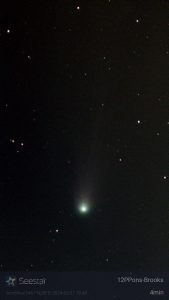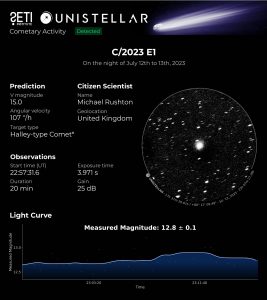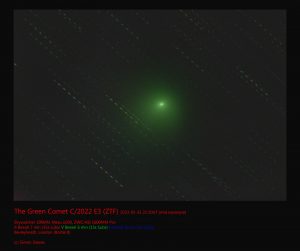Comets are usually named after their discoverer(s) family name, although with science increasingly being the result of large team efforts, the name of the team or project can be more appropriate so is often used.
Comet 12P/Pons-Brooks by Jim Burchell
Another fantastic image of Comet 12P/Pons-Brooks captured on the 27th March 2024 by Jim Burchell using his Seestar S50 smart scope. The image consists of 24 x 10 second images stacked.

For more information about the comet 12P Pons-Brooks check out https://ras.ac.uk/news-and-press/news/12ppons-brooks-how-and-when-see-devil-comet
Comet 12P/Pons-Brooks by Jim Burchell
Two fantastic images of Comet 12P/Pons-Brooks taken on the 15th & 18th March 2024 by member Jim Burchell. The images were taken using a Seestar S50 smartscope. On both nights Jim had a very small amount of time to capture the comet due to clouds rolling in. The image taken on the 15th is a stack of 6×10 second images and the image on the 18th is a stack of 18×10 second images.
Comet 12P/Pons Brooks on 15th March 2024

Comet P12/Pons Brooks on 18th March 2024

For more information about the comet and how to locate it check out https://www.skyatnightmagazine.com/advice/comet-12p-pons-brooks
Comet Lemmon C/2023 H2 – Nov 2023
Superb image of Comet Lemmon C/2023 H2 taken by member Richard Bohner on the 11th Nov 2023 from Arizona, USA. Richard used the following to acquire his image – Canon 5D Mk IV on a Celestron 8” SCT. Magnification about 100X. 60 seconds exp. At ISO 10K.

The comet was discovered on April 23, 2023 with a robotic 1.5m reflector telescope of the Mount Lemmon Survey, hence the name Comet Lemmon (C/2023 H2). That program is part of the Catalina Sky Survey based at Stewart Observatory’s Catalina Station near Tucson, Arizona, which combs the sky each night in search of new comets and asteroids. The comet is just one of an incredible 50,000 asteroids and comets discovered by the Mount Lemmon Survey, making it one of the most prolific minor planet-discovering surveys currently operating.
During mid-November the comet was moving across the western sky from the constellation Hercules through Aquila just below the Summer Triangle asterism.
Comet C/2023 P1 (Nishimura) imaged by Martin Crow
C/2023 P1 (Nishimura) is a long-period comet discovered by Hideo Nishimura on 12 August 2023 and member Martin Crow imaged it on the 20th August 2023. At the time of its discovery, the comet was in the constellation of Gemini and shining at magnitude +10.4.

Image details: 5x60sec exposures. 235mm diameter SCT @ f5.4, SX694 mono CCD.
Comet C/2023 E1 (ATLAS) by Dr. Mike Rushton
A rather splendid image of Comet C/2023 E1 (ATLAS) taken by CMHASD trustee and secretary Dr. Mike Rushton on the 12/13th July 2023 in Ursa Minor.
Mike wrote ”This is C/2023 E1 (ATLAS) last night. Approx Mag 14.5 with a greenish coma. The bright star in the image is Mag 7 and the limiting Mag 17.5. Perihelion was 1/7/23 and closest to earth will be on 18/8/23. This was a 20 min exposure with my eVscope.” Imaging started just before midnight on 12/7/23 (23:57 BST).

Comet C/2023 E1 (ATLAS) was spotted on the 1st March 2023 by the NASA funded Asteroid Terrestrial-impact Last Alert System (ATLAS). At the time, the comet was a +19th magnitude object moving through the constellation of Virgo.
On July 1 this Comet ATLAS reached perihelion, its closest approach to the Sun.
To date the comet has now moved into Draco and will move into Cepheus towards its closest approach to Earth mid-August. On August 18 this visitor to the inner Solar System will only be 3 light-minutes or so from our planet.
Based on its inclination to the ecliptic plane (38 degree) and orbital period of about 85 years C/2023 E1 (ATLAS) is considered a Halley-type comet. Though the comet currently has a ‘C’ designation for a long period comet versus periodic comet; that will probably change as 85 years is much less than the 200 year orbital period cut off defining the 2 categories of comet.
Below is the report from SETI/UNISTELLAR Mike received back after submitting his imaging data.
Mike said ”I have had the photometry back and it was brighter than I thought at Mag 12.8. See the report from seti below. The little image in that report is stacked on the moving comet. The original image I sent was stacked on the stars.”

For more information: https://www.space.com/comet-c2023-e1-atlas-little-dipper-how-to-see
Comet C/2022 E3 (ZTF) by George Buckberry – 14th Feb 2023
The latest image of the Green Comet C/2022 E3 (ZTF) that is currently gracing our skies by member George Buckberry. The photo was taken on the 14th February 2023 by George.
”Having spent months climbing up out of Corona Borealis and drifting past the Big and Little Dippers, like a rollercoaster car reaching its highest point, Comet C/2022 E3 ZTF has now gone ‘over the top’ of its path across the northern sky and is falling south, fading in brightness and shrinking in size as it drops towards Taurus. For northern hemisphere comet chasers and skywatchers E3’s show is almost over.” ref https://www.skyatnightmagazine.com/advice/comet-c-2022-e3-ztf/
So well done George for capturing the Comet, you did well to get it as it’s fading fast!

George has written on the image below of how he acquired the photo and the location of the star Aldebaran to the comet. Aldebaran (Alpha Tauri) is a bright red giant star in the constellation of Taurus.

Comet C/2022 E3 (ZTF) by Martin Crow
Member and trustee Martin Crow captured the Comet C/2022 E3 (ZTF) on the morning of the 18th January 2023 at 03:20am. The ion tail of the comet can be seen emerging at around the 2 o’clock angle in the photos.


Comet C/2022 E3 (ZTF) on the 7th Feb 2023 by Honor Wheeler and 8th Feb 2023 by Simon Dawes
Member Honor Wheeler captured the Green Comet C/2022 E3 (ZTF) on the 7th February 2023 using a Canon M6 with a 400mm lens on a Star Adventurer tracking mount. ISO1600, 30″ expsoure. The comet is centre right in the image in the constellation Auriga. The bright star Capella is above the comet at the 10 o clock position from the comet and the star Elnath is below the comet between the 6 & 7 o clock position from the comet.

Then just before Moon rise on the 8th February 2023 member Simon Dawes captured this image of the green comet. Details of how Simon acquired the image are included on the photo.

Comet C/2022 E3 (ZTF) by Simon Dawes on 31st Jan 2023
Super image of Comet C/2022 E3 (ZTF) taken by member Simon Dawes with Bessel/Cousins photometric filters and a broadband LPS filter (IDAS LPS D2) then combined to give an RGB image, colour hasn’t been altered. More detail of how Simon acquired his image is on the photo.

C/2022 E3 (ZTF) is a long period comet from the Oort cloud that was discovered by the Zwicky Transient Facility (hence the ZTF in the Comet’s name) on 2 March 2022, using the 1.2-m, f/2.4 Schmidt telescope at Mount Palomar. It was the 3rd such object discovered in the fifth half-month (A, B, C, D, E) of the year. Thus, 2022 E3 (ZTF).
The comet has a bright green glow around its nucleus due to the effect of sunlight on diatomic carbon and cyanogen.
Comet C/2022 E3 (ZTF)- 29th & 30th Jan 2023 by Jim Burchell


Other Images
Sun | Comets | Mercury | Venus | Atmospheric Optics | Meteors | Auroa and NLC | Moon | Minor Planets | Mars | Jupiter | Saturn | Uranus | Neptune | Messier | Caldwell | All Deep Sky | Conjunctions | Transits | Solar Eclipse | Lunar Eclipse | Wide Field |ISS & Space Junk | Exo-Planets
All images are copyright. Permission must be sought to from the image owner to the use of any of these images.

